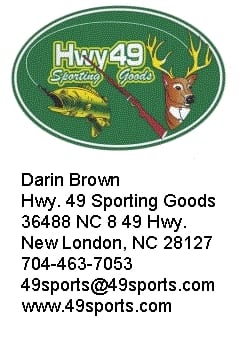By Darin Brown
Summertime fishing on the Yadkin river lakes can be the best time of the year for catching great numbers of several species of fish. It’s hot so be sure to stay hydrated if you are fishing from late morning to late evening.
Catfish love the hot weather and you can catch them during the day or you can beat the heat and catch them at night. A standard catfish rig consists of a sliding egg weight, a plastic or glass bead, a swivel and a circle bait hook. The sliding sinker allows the fish to feel virtually no resistance when he picks it up. This is what is known as a ìCarolina Rigî. In the heat of the day look for deeper holes or pockets in the area you are fishing and drop a line into them. Cut shad, bream or dip baits work well for fishing these holes. Dip baits are usually fished on a ìcatfish wormî. This is a piece of soft plastic that holds the dip bait. Dip bait like the Catfish Charlie brand work surprisingly well but you must be careful when casting so as not to sling your bait off. Another area that produces some nice catfish during the day is the tailrace behind the dams. Due to the current you may need to use a heavier sinker. I don’t recommend dip bait in the tailraces because the bait washes off too fast in the current.
If you really want to beat the heat and catch catfish try jug/noodle fishing or trot lines at night. Some special restrictions apply to this type of fishing so check your regulations to be sure you are not in violation of any laws. My number one choice for bait on jugs/noodles or trot lines is cut shad. (Live bait is not allowed on jugs/noodles or trot lines) The only other bait I use occasionally is cut bream. For some reason, bream that are caught in farm ponds or creeks do not work nearly as well as bream caught from the lake you are fishing. Jug/noodle fishing simply consists of a plastic bottle or a commercially made noodle with a few feet of line (masonry cord works great) with a baited hook placed in the water and checked periodically as it drifts around. (Maximum number of jugs/noodles allowed is 70) Trot lines are usually purchased at your local sporting goods store and usually are 100 to 150ft long with 20-40 drop lines with hooks. Anchor one end of the main line to an anchor or cement block, tie a jug onto the main line at the waters surface. Let out the line moving parallel to the shore until you get about half way and then tie on another jug. Then do the same at the other end of the main line and anchor the end like you did at the start. Your main line should be floating near the surface now with the drop lines and hooks hanging down into the water a couple of feet. Bait each hook and check ever so often. You can usually tell when a fish is on the line when the jugs begin jerking around or are partially sumberged. N.C. Wildlife regulations require that all trot lines be set parallel to the nearest shore. Trot lines, Jugs/noodles, or set hooks must all have the users name, address and WRC number (fishing license id) legibly inscribed on them. Again, check the regulation book for any restrictions that may apply.
The white perch fishing has been great lately, especially on Badin lake. A great thing about white perch this time of year is that if you find them they will almost always bite. Small spoons and lures work on them but a small piece of cut bait (shad, bream, shiner etc.) on a #6 or #8 bait hook is probably the easiest way to catch them. The average size of these fish have increased over the last several years and we are seeing a lot of fish in the 1 to 1Ω lb size. They can be found in about any area of the lakes but certain areas seem to consistently produce fish. White perch love a little moving water so the tailraces below the dams are a great place to catch them. Large schools of these fish are also often found roaming around the islands in the Beaver Dam Creek area on Badin lake. White perch tend to be shallow early in the morning and migrate deeper as the temperature heats up.
Crappie can be found in deep water near structure. Crappies are being caught in areas where the water depth increases suddenly. These ledges often hold a lot of fish. Troll around these areas until you catch a few fish. When you catch a couple double back thru the same area and if you catch more in the same area anchor out from the area and cast a small jig or minnow until the fish stop biting and then start trolling around again. Areas just off the main river channels are excellent places to find them this time of year. This is the time of year when a good fish finder will be very useful. Try the mouth of Crane Creek, Second Creek, or Abotts Creek on High Rock Lake. Riles Creek or Newsome Creek on Tuckertown Lake are good areas as well.
This time of year brings the recreational crowd out. The jet skis and boaters are everywhere so be aware of them and have a great summer.
